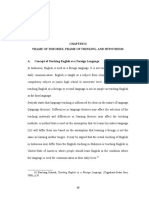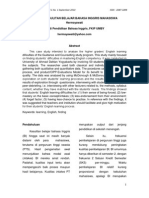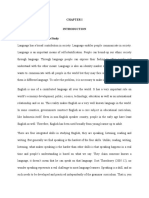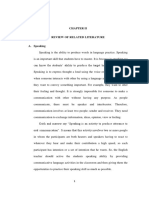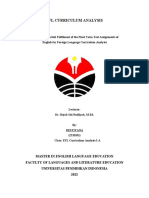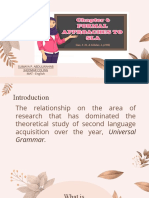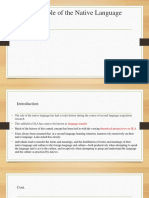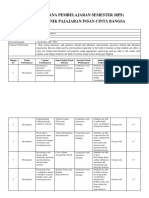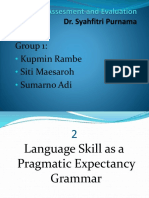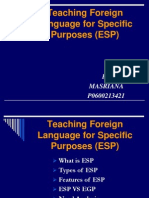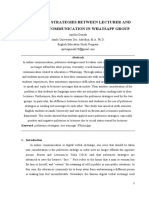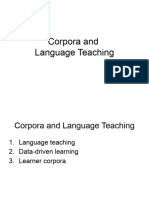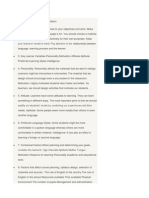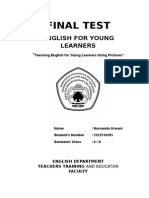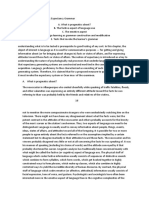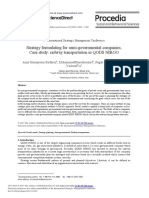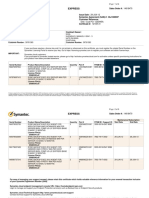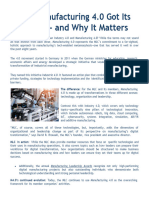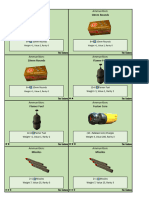Learner Errors and Error Analysis WENI
Uploaded by
Weni RatnasariLearner Errors and Error Analysis WENI
Uploaded by
Weni RatnasariName : Weni Ratnasari
Class : Rombel 3
Language Acquisition
Learner Errors and Error Analysis
Introduction
Learners make errors in both comprehension and production. Also, even adult native
speakers sometimes make errors. The study of errors is carried out by means of Error
Analysis (EA). In the 1970s, EA supplanted Contransive Contrastive Analysis (CA), which
sought to predict the errors that learners make by identifying the linguistic differences
between their L1 And target language.
Collection of a sample of learner language
The starting point in EA is deciding what samples of learner language to use for the
analysis and how to collect these samples. We can identify three broad types of EA according
to the size of the sample. A massive sample involves collecting several samples of language
use from a large number of learners in order to compile a comprehensive list of error,
representative of the entire population. The errors that learner make can be influenced by a
variety of factors. Decisions also need to be made regarding the manner in which the samples
are to be colllected. An important destinction is whether the learner language reflects natural,
spontaneous language use, or is elicited in some way.
Identification of Errors
Aa error can be defined as a deviation from the norms of the terget language. This
definition raises a number of questions, however, first,there is the question regarding which
variety of the target language should serve as the norm. A second question concerns the
distinction between errors and mistakes. An error takes place when the deviation arises as a
result of lack of competence. A mistake occurs when learners fail to perform their
competence. A third question concerns whether the error is overt or cover. An overt error is
easy to identify because there is a clear deviation in form. A covert error occurs in utterances
that are superficially well-formed but which do not mean what the learner intended them to
mean. A fourth question concerns whether the analysis should examine only deviations in
correctness or also deviations in appropriateness.
Name : Weni Ratnasari
Class : Rombel 3
Language Acquisition
Description of Errors
The description of learner errors involves a comparison of the learners idio-syncratic
utterances with a reconstruction of those utterances in the target language. It requires,
attention to the surface properties of the learners utterances. Perhapps the simplest type of
descriptive taxonomy is one based on linguistic categories. This type is closely associated
with a traditional EA under taken for pedagogic purposes, as the linguistic categories can be
chosen to correspond closely to those found in structural syllabuses and language text books.
An alternative to a linguistic classification of errors is to use a surface strategy taxonomy.
This highlights the ways surface structures are altered by means of such operations as
omissions, additions and regularizations. In order to identify these different kinds of errors,
however, it is necessary to interview the learner. The description of errors, like their
identifiction, is problematic. Even if the occur itself can be easily identified, it is often
problematic to determine what the error consists of.
Explanation of Errors
Explanation is concerned with establishing the source of the error, i.e accounting for
why it was made. This stage is the most important for SLA research as it involves an attempt
to establish the processes responsible for L2 acquisition. As Taylor points out, the error
source may be psycholinguistic, sociolinguistic, epistemic, or may reside in the discourse
structure. Psycholinguistic sources involve such matters as the learners ability adjust their
language in accordance with the social context. Epistemic sources concern the learners lack
of world knowledge, while discourse sources involve problems in the organization of
information into a coherent text.
The distinction between errors and mistakes, which has already been discussed
with regard to the identification stage of EA, is also relevant in explaining deviatins
demonstrating the interdepence of these two steps in EA. Any deviation from target-language
norms may reflect either a problem in performance or in competence. It is customary to
distinguish another general source of errors. Induced errors occur when learners are led to
make errors by the nature of the instruction they have received.
Name : Weni Ratnasari
Class : Rombel 3
Language Acquisition
Evaluating Errors
Whereas all the preceding stages of EA have involved an examination of errors from
the point of view of the learner who makes them, error evaluation involves a consideration of
the effect that errors have on the person addressed. The design of error evaluation studies
involves decisions on who the adressees will be, what errors they will be asked to judge, and
how they will be asked to judge them. The judges can vary according to whether they are
native speakers or non-native speakers, and also according to whether they are expert or
non-expert.
The Limitations of Error Analysis
A frequently mentioned limitation is that EA fails to provide a complete picture of
learner language. We need to know what learners do correctly as well as what thay do
wrongly. EA is limited in a second way. Most of the studies are cross-sectional in nature,
affording only a very static view of L2 acquisition. As a result, EA has not proved very
effective in helping us understand how learners develop a knowledge of an L2 over time.
Summary
Error analysis (EA) was one of the first methods used to investigate learner language.
The first step in carrying out an EA was to collect a massive, specific, or incidental sample of
learner language. The sample could consist of natural language use or be elicited either
clinically or experimentally. It could also be collected cross-sectionally or longitudinally.
You might also like
- What Color Is Your Parachute? Job-Hunter's Workbook Tablet Edition10% (10)What Color Is Your Parachute? Job-Hunter's Workbook Tablet Edition3 pages
- Computed Tomography e Book Physical Principles Clinical Applications and Quality Control PDF50% (2)Computed Tomography e Book Physical Principles Clinical Applications and Quality Control PDF2 pages
- The Collection of Language Assessment IndicatorsNo ratings yetThe Collection of Language Assessment Indicators16 pages
- Skripsi The Influence of The Ability in Mastering Dialogue On The Achievement in Learning English To The Second Year Students at M A N Magelang50% (2)Skripsi The Influence of The Ability in Mastering Dialogue On The Achievement in Learning English To The Second Year Students at M A N Magelang32 pages
- Analisis Kesulitan Belajar Bahasa Inggris MahasiswaNo ratings yetAnalisis Kesulitan Belajar Bahasa Inggris Mahasiswa14 pages
- Fakultas Keguruan Dan Ilmu Pendidikan: Ujian Tengah Semester Genap TAHUN AKADEMIK 2020/2021No ratings yetFakultas Keguruan Dan Ilmu Pendidikan: Ujian Tengah Semester Genap TAHUN AKADEMIK 2020/20212 pages
- A Blended Learning Environment For Individualized English Listening and Speaking Integrating Critical Thinking 2013 Compu 1No ratings yetA Blended Learning Environment For Individualized English Listening and Speaking Integrating Critical Thinking 2013 Compu 121 pages
- PTK Bahasa Inggris Sma - The Effect of Applying Snowball Throwing Model Assisted by Audio On The Students' Reading ComprehensionNo ratings yetPTK Bahasa Inggris Sma - The Effect of Applying Snowball Throwing Model Assisted by Audio On The Students' Reading Comprehension63 pages
- Group 8-Sociolinguistics (Chapter 8) Ethnicity and Social NetworkNo ratings yetGroup 8-Sociolinguistics (Chapter 8) Ethnicity and Social Network6 pages
- Contrastive Linguistics and Error AnalysisNo ratings yetContrastive Linguistics and Error Analysis92 pages
- What Is Grammer and Two Types of Teaching GrammerNo ratings yetWhat Is Grammer and Two Types of Teaching Grammer2 pages
- The Use of Picture Series To Improve The Writing Skills of Tenth Grade Students of Sma N 1 Srandakan in Writing Narrative Texts in The Academic Year of 2013No ratings yetThe Use of Picture Series To Improve The Writing Skills of Tenth Grade Students of Sma N 1 Srandakan in Writing Narrative Texts in The Academic Year of 201319 pages
- Summary of Acting and Conversing SociolinguisticsNo ratings yetSummary of Acting and Conversing Sociolinguistics3 pages
- Download Full The Teacher s Big Book of Graphic Organizers 100 Reproducible Organizers that Help Kids with Reading Writing and the Content Areas Jossey Bass Teacher 1st Edition Katherine S. Mcknight PDF All Chapters100% (1)Download Full The Teacher s Big Book of Graphic Organizers 100 Reproducible Organizers that Help Kids with Reading Writing and the Content Areas Jossey Bass Teacher 1st Edition Katherine S. Mcknight PDF All Chapters55 pages
- Makalah Speaking Academic - Group 5 2003No ratings yetMakalah Speaking Academic - Group 5 200349 pages
- Language Assessment, Brown & Abeywickrama (2019) - Chapter 10 SummaryNo ratings yetLanguage Assessment, Brown & Abeywickrama (2019) - Chapter 10 Summary3 pages
- Sociolinguistics-Mini Research Aprilia Gunadi A1B218037 R002No ratings yetSociolinguistics-Mini Research Aprilia Gunadi A1B218037 R0029 pages
- Analysis of The Speech Acts in A Language Class EssayNo ratings yetAnalysis of The Speech Acts in A Language Class Essay4 pages
- Vocabulary Dan Tentang Word Building.: WWW - Esl.galaxy/prefixes (28No ratings yetVocabulary Dan Tentang Word Building.: WWW - Esl.galaxy/prefixes (282 pages
- Lecture Corpora and Language Teaching SlidesNo ratings yetLecture Corpora and Language Teaching Slides30 pages
- FULL the Basic Principles of English Language Teaching 2 460a8867 4cfd 48c9 8f93 62278dad03e7No ratings yetFULL the Basic Principles of English Language Teaching 2 460a8867 4cfd 48c9 8f93 62278dad03e7201 pages
- UAS-Teaching English For Young Learners Using PicturesNo ratings yetUAS-Teaching English For Young Learners Using Pictures6 pages
- [Ebooks PDF] download How to design and evaluate research in education 6Rev Ed Edition Jack R. Fraenkel full chapters100% (8)[Ebooks PDF] download How to design and evaluate research in education 6Rev Ed Edition Jack R. Fraenkel full chapters70 pages
- UTS Khairunnisa BR Malau 2310201021 Sem IINo ratings yetUTS Khairunnisa BR Malau 2310201021 Sem II6 pages
- Sheykah (2015) A Comparative Study of Expressive Speech ActsNo ratings yetSheykah (2015) A Comparative Study of Expressive Speech Acts13 pages
- Comparison Between Binary and Non Binary in English and BahasaNo ratings yetComparison Between Binary and Non Binary in English and Bahasa8 pages
- Language Skill As A Pragmatic Expectancy GrammarNo ratings yetLanguage Skill As A Pragmatic Expectancy Grammar2 pages
- " Error Analysis " Answer The Following Questions. Use Your Own Power or Proper CitationNo ratings yet" Error Analysis " Answer The Following Questions. Use Your Own Power or Proper Citation4 pages
- Summary Chapter 2 Learner Errors and Error Analysis100% (1)Summary Chapter 2 Learner Errors and Error Analysis3 pages
- Intellectual Property: What Do Teachers and Students Know?No ratings yetIntellectual Property: What Do Teachers and Students Know?13 pages
- Sciencedirect: Strategy Formulating For Semi-Governmental Companies, Case Study: Railway Transportation in Qods NirooNo ratings yetSciencedirect: Strategy Formulating For Semi-Governmental Companies, Case Study: Railway Transportation in Qods Niroo11 pages
- Up to 70 off Certified Refurbished iPhone XS MaxNo ratings yetUp to 70 off Certified Refurbished iPhone XS Max1 page
- Ventilation for Environmental Tobacco Smoke 1st Edition Brian A Rock - The latest ebook version is now available for instant access100% (1)Ventilation for Environmental Tobacco Smoke 1st Edition Brian A Rock - The latest ebook version is now available for instant access48 pages
- Questionnaire For Avon Franchise DealersNo ratings yetQuestionnaire For Avon Franchise Dealers4 pages
- Law of Conservation of Matter Lab: Teacher NotesNo ratings yetLaw of Conservation of Matter Lab: Teacher Notes5 pages
- 2nd Term Test 3 ESO 2021-2022 - Documentos de GoogleNo ratings yet2nd Term Test 3 ESO 2021-2022 - Documentos de Google3 pages
- Manufacturing and Industrial Engg - 240118 - 172231No ratings yetManufacturing and Industrial Engg - 240118 - 1722311 page
- Pharmacy Calculations: Random Problems: Actimed by Generika DrugstoreNo ratings yetPharmacy Calculations: Random Problems: Actimed by Generika Drugstore17 pages
- Fallout 2d20 - Loot Cards - Wave 4 - The EnclaveNo ratings yetFallout 2d20 - Loot Cards - Wave 4 - The Enclave10 pages
- EX5218-Report-Vol1-Sec1-Certificate of Compliance-20150528 - 55L - 55L-60No ratings yetEX5218-Report-Vol1-Sec1-Certificate of Compliance-20150528 - 55L - 55L-601 page








